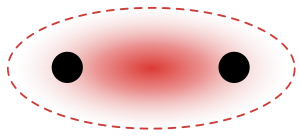Sigma bond facts for kids
A sigma bond (often written as σ bond) is a special type of chemical bond. Think of it as a strong "handshake" between two atoms. It's the strongest kind of covalent bond, which is when atoms share electrons.
In a sigma bond, the electron clouds (called atomic orbitals) from two atoms come together and overlap directly, head-on. Imagine two balloons pushing into each other from the ends. This is different from a pi bond, where the electron clouds touch sideways, like two balloons touching along their sides. Because sigma bonds overlap head-on, they are much stronger.
Sigma bonds can form using different types of electron clouds, like s, p, d, or f orbitals. The important thing is that these clouds must have the right shape and direction (what scientists call "symmetry") to line up perfectly and form the bond.
Since the σ bond is very strong, the shared electrons in this bond are held tightly and have low energy. This makes the molecule stable. There's also something called an "antibonding orbital" (σ*), which is like the opposite of a bonding orbital. It has high energy because it would make the atoms push apart instead of stick together.
Contents
What is a Chemical Bond?
A chemical bond is like a "glue" that holds atoms together to form molecules. Atoms bond because it makes them more stable, usually by letting them have a full outer shell of electrons.
Types of Bonds
There are different ways atoms can bond:
- Covalent bonds: Atoms share electrons. Sigma bonds are a type of covalent bond.
- Ionic bonds: One atom gives electrons to another, creating charged particles that attract each other.
- Metallic bonds: Found in metals, where electrons are shared freely among many atoms.
How Sigma Bonds Form
Sigma bonds form when atomic orbitals overlap directly along the line connecting the two atomic nuclei. This direct overlap creates a strong connection.
Electron Sharing
When a sigma bond forms, the electrons are shared in the space directly between the two atoms. This area of shared electrons is very dense, which is why the bond is so strong.
Examples of Sigma Bonds
You can find sigma bonds in many common molecules:
- Hydrogen gas (H₂): Two hydrogen atoms each have one s-orbital. These s-orbitals overlap head-on to form a sigma bond.
- Methane (CH₄): The carbon atom forms four sigma bonds with four hydrogen atoms.
- Ethane (C₂H₆): There's a sigma bond between the two carbon atoms, and each carbon also forms sigma bonds with three hydrogen atoms.
Sigma vs. Pi Bonds
While sigma bonds are formed by head-on overlap, pi bonds (π bonds) are formed by sideways overlap of p-orbitals.
- Sigma bonds: Stronger, allow free rotation around the bond.
- Pi bonds: Weaker than sigma bonds, prevent free rotation around the bond.
In molecules with double or triple bonds, there's always one sigma bond, and the extra bonds are pi bonds. For example, a double bond has one sigma and one pi bond, and a triple bond has one sigma and two pi bonds.
Images for kids
See also
In Spanish: Enlace σ para niños



